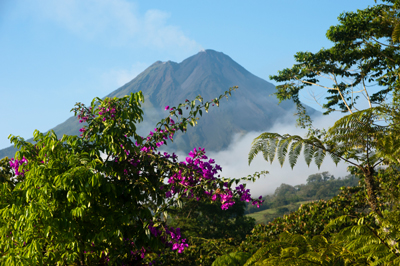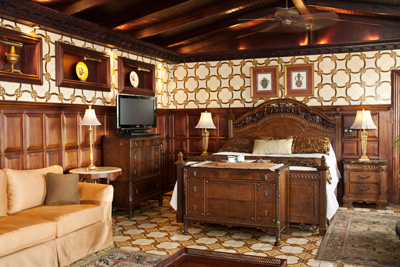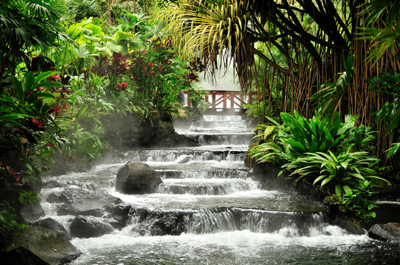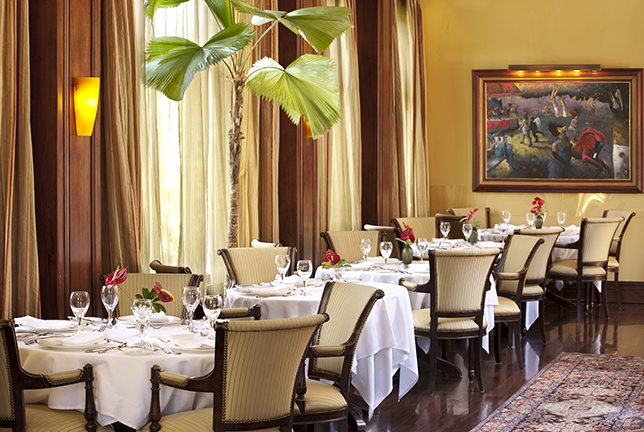
Costa Rica has a bit of a rip-roaring reputation to maintain. After all, over the past several decades, adrenaline junkies have built an adventure-tourism industry out of the country’s verdant, ocean-to-sea landscape and Ring of Fire terrain. But the same rainforest canopy that drops zip lines and waves that toss surfers are teeming with unique ingredients ripe for a chef’s imagination, and the past few years have brought a culinary evolution as international chefs arrive and local toques return to do their part to change the bland perception of Costa Rican cooking. These three itineraries offer a delicious sampler of food experiences for those looking to explore the new frontier of Latin American cuisine.
San José
Travelers often dismiss Costa Rica’s sprawling, low-rise capital as little more than a gateway to lusher locales; but as the de facto headquarters of the country’s burgeoning food scene—when we asked one prominent local chef for restaurant recommendations in the city, he rattled off no less than 15 places we must get a table—it’s worth a longer look.
 Where to stay: The historic but impeccably updated Hotel Grano de Oro offers 40 uniquely designed rooms behind its Victorian façade, stained-glass windows and jungle’s worth of tropical flowers and greenery. Each room has its charms—three of the six deluxe patio rooms even feature fountains stocked with fish—but book rooms 16 through 21 and you’ll be greeted by a light-, fern- and palm-filled courtyard each time you open your door. Hotel Grano de Oro is both socially and environmentally conscious (right down to selling local wares in its shop—stock up on the cardamom-flavored organic Sibú chocolate bars), but equally committed to service; when one frequent guest could not book her usual fountain room, the staff surprised her with a goldfish in a fishbowl for her stay.
Where to stay: The historic but impeccably updated Hotel Grano de Oro offers 40 uniquely designed rooms behind its Victorian façade, stained-glass windows and jungle’s worth of tropical flowers and greenery. Each room has its charms—three of the six deluxe patio rooms even feature fountains stocked with fish—but book rooms 16 through 21 and you’ll be greeted by a light-, fern- and palm-filled courtyard each time you open your door. Hotel Grano de Oro is both socially and environmentally conscious (right down to selling local wares in its shop—stock up on the cardamom-flavored organic Sibú chocolate bars), but equally committed to service; when one frequent guest could not book her usual fountain room, the staff surprised her with a goldfish in a fishbowl for her stay.
Where to eat: You don’t have to go far for one of the city’s best meals—fine dining in San José is defined by Hotel Grano de Oro’s elegant Restaurante Grano de Oro. A local favorite for special occasions—it’s especially popular with those looking to pop the question—the eatery is helmed by French chef Francis Canal, who prepares Costa Rican ingredients using European techniques. The result is an ever-changing menu with entrées such as grilled Costa Rican tilapia with herb butter, fennel and mini ratatouille. Restaurante Grano de Oro is also known for its wine program, so opt for pairings with your courses or simply enjoy a glass at the polished-wood bar that extends into the restaurant’s courtyard. And do not skip the crème brûlée. Local, organic vanilla beans give it a perfectly sweet finish.
What to do: For a high-low view of why San José is heating up as a hotbed of culinary creativity, head to the 1-year-old Centro Gastronómico Sabores in the affluent Escazú suburb and the 133-year-old Mercado Central downtown. The latter is a shining example of a heaving city market, where you can buy everything from chili peppers to flowers to dresses as you snack your way through its maze. One counter you must hit: Soda Tapia, a 120-year-old corner café serving one of the city’s best tamales and casados (a traditional mélange of rice, beans, plantains and meat). If you’re still hungry after Mercado Central, cross the street and continue your culinary journey at Mercado Borbón, a secondary market in operation since 1950.
Sabores, meanwhile, may be the literal headquarters of the new Costa Rican cuisine. The brand has been at the forefront of elevating the country’s tropical flavors by reintroducing ingredients such as guaba (the cream-covered, pod-like “ice-cream-bean”) and incorporating more diverse spices and techniques. Sabores launched as a culinary magazine in 2003; a daily cooking show followed; and, in 2012, Centro Gastronómico Sabores opened as a television set, learning center and restaurant. Costa Rica’s new breed of celebrity chefs tear through the building’s state-of-the-art kitchens, preparing recipes for the TV show or teaching classes—students in a macaron class were just piping their creations into disks when we visited. While most classes are in Spanish, English instruction is available upon request, and class recipes range from coconut-water cocktails to classic cajeta desserts, flavored with a caramel-like syrup.
Manuel Antonio
A Pacific Coast town adjacent to the monkey- and sloth-topped trees of its eponymous national park, Manuel Antonio offers more than beaches and wildlife. It’s also home to an organic spice plantation that welcomes visitors and a sustainable resort bulking up its kitchen credentials to become a national culinary heavyweight.
 Where to stay: If it’s spectacular scenery that first draws you to Arenas Del Mar Beachfront & Rainforest Resort—the 38 guest rooms are split among seven buildings perched at varying heights between the beach and the rainforest-covered hills—it’s the glow of warm hospitality that will summon you back. That and the well-appointed guest rooms (outdoor coffee station included), endless activities and top-notch culinary program. One standout onsite diversion is a tortilla-making class with Mama Elisa; let the expert guide you through adding corn flour, sour cream and queso fresco before washing down your finished snack with a glass of agua dulce. Other resort activities include nature hikes (listen for howler monkeys), a back-of-house sustainability tour exploring the property’s eco-friendly measures and nightly programs such as rum tastings. Arenas Del Mar is the type of place where not only will staff members know your name within one day, but so will the other guests.
Where to stay: If it’s spectacular scenery that first draws you to Arenas Del Mar Beachfront & Rainforest Resort—the 38 guest rooms are split among seven buildings perched at varying heights between the beach and the rainforest-covered hills—it’s the glow of warm hospitality that will summon you back. That and the well-appointed guest rooms (outdoor coffee station included), endless activities and top-notch culinary program. One standout onsite diversion is a tortilla-making class with Mama Elisa; let the expert guide you through adding corn flour, sour cream and queso fresco before washing down your finished snack with a glass of agua dulce. Other resort activities include nature hikes (listen for howler monkeys), a back-of-house sustainability tour exploring the property’s eco-friendly measures and nightly programs such as rum tastings. Arenas Del Mar is the type of place where not only will staff members know your name within one day, but so will the other guests.
Where to eat: El Mirador Bar & Restaurant, Arenas Del Mar’s signature eatery, is upping the ante on Costa Rica’s coastal cuisine. In the past two years, the resort has brought in a new head chef, Adrian Cerdas, from JW Marriott Guanacaste Resort & Spa, and launched a visiting-chef program that flies in prominent U.S. chefs for a series of five-course tasting menus. When we were there, Philadelphia toque and Top Chef alum Jason Cichonski was doing a three-night stint collaborating with Cerdas to turn out course after course of inventive takes on local ingredients. When pork tenderloin with chocolate, tamarind and yucca arrived, the cacao paste the chefs had procured from the nearby Villa Vanilla Spice Plantation three hours earlier had traveled no more than 10 miles and had barely had a chance to cool off. El Mirador’s open-air feel—there are no walls to keep out curious monkeys or ocean views—belies the mastery (mostly organic, of course) that is happening in its kitchen.
What to do: Happily, Villa Vanilla isn’t open only to culinary VIPs; anyone can visit the 27-acre organic spice plantation for a tour and tasting, provided a few car-rattling dirt roads don’t bother you. The bumpy ride is a small price to pay for the foodie nirvana found on the farm. As harvesters peel cinnamon bark and chop turmeric on either side of you, your tour guide explains the plantation’s crops, from black pepper to Ceylon cinnamon, in a hands-on demonstration that includes cutting a cacao fruit in half and popping a sweet, slimy seed into your mouth. You’ll hike through the farm’s trees to a hilltop viewpoint, where you’ll taste Villa Vanilla’s bounty in a succession of sweets such as chili-spiked brownies with vanilla-bean ice cream. Don’t leave without a visit to the rustic spice shop.
Within 30 minutes of landing at San José’s international airport, you can be trekking through coffee farms and tasting some of the freshest brews on earth. Ascend to the coffee zone between 3,000 and 6,000 feet above sea level to experience life in the green hills that produce the country’s most important crop: arabica beans.
Where to stay: Finca Rosa Blanca Coffee Plantation & Inn could be called a mecca for coffee aficionados, environmentalists, architecture buffs and get-away-from-it-all globetrotters alike. The eco-leader inn and coffee plantation, where the main lodge’s adobe curves recall Antoni Gaudí’s work, is nestled in Santa Bárbara de Heredia, itself an excellent place to explore what small-town life is like in Costa Rica. If you never leave the resort, though, it’s with good reason—besides walking trails, a chemical-free infinity pool and vistas for days, Finca Rosa Blanca makes guests feel at home with touches such as a cozy library and an expansive outdoor dining area overlooking the lights of San José. Thirteen rustic-luxe rooms (think crisp, white bamboo linens and super-charged Wi-Fi, but no TVs) are each individually and fancifully decorated. Glenn Jampol, who owns and operates the hotel with his wife, Teri, is himself an artist, and the couple regularly commission local artists to create the colorful murals and nature-inspired ironworks found on seemingly every inch of the property.
Where to eat: El Tigre Vestido Restaurant and Bar Búho, located at Finca Rosa Blanca, take full advantage of the hotel’s onsite fruit trees and hydroponic herb greenhouse in dishes that range from ocean-fresh tuna tartare to a traditional casado lunch (rice, black beans, plantains, salad, vegetables, housemade tortillas and chicken, beef fajitas or fish) with chillero, a spicy Costa Rican salsa. For coffee buffs, though, the unique pièce de résistance here is the chef’s six-course coffee tasting menu, in which each course is created using the so-called “golden bean.” The plantation’s coffee isn’t the only local star of the lunch or dinner; expect courses such as roasted-tomato-espresso soup and chicken with tamarind and coffee sauce, topped with boiled, deep-fried yucca and garnished with a coffee leaf.
What to do: The coffee tour at Finca Rosa Blanca is more than a glimpse into the workings of the plantation; it’s a two-hour journey to coffee connoisseurship. Before entering the 42-acre growing area, your guide will outfit you with a rubber-tipped walking stick—you’ll need the extra support for this light hike up natural stairs and through 5,000 indigenous trees, as Finca Rosa Blanca’s shade-grown estate looks more like a native forest than a traditional plantation. The hands-on journey goes beyond coffee to include a lesson in sustainable and organic farming—everything you see, from the sponge-like banana trees to the erosion-stopping wild iris, serves a purpose—before winding through the processing plant and roasting room. From there, you’ll head to El Tigre Vestido for a coffee cupping session that illuminates the complexities and riches of quality beans in much the same way a wine tasting reveals layers of flavors. Visit Finca Rosa Blanca during harvest season, between October and January, to see picking and roasting in action, or expand your trip (and your palate) with the “Coffee, Cacao and Cheese Trail” that the hotel co-produces with Monte Azul, a luxury eco-resort and farmstead cheese producer located at the foot of Cerro Chirripó, Costa Rica’s highest mountain. Taste this unique highlands terroir in Monte Azul cheeses such as Chirripó Negro, which is coated with local coffee-berry ash.
Photos Courtesy of Hotel Grano de Oro, istock-Keith Binns and istock-Chris Williams


